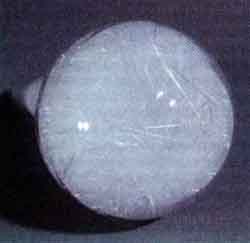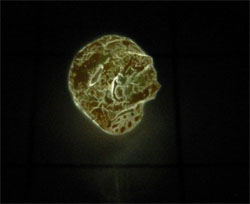



Sulfur
Sulfur S - hard, brittle, yellow crystalline substance with a melting point 119,3°C. But do not mix this sulfur with the sulfur on the matches. On the heads of matches are mostly complex substances, one of thet is potassium chlorate (KClO3), it is able to ignite with friction or temperature. Sulfur is a simple substance and is present here as one of the components of the head of a match.Modification of sulfur:
here are two modifications of sulphur: brittle sulphur and plastic sulphur. At 113 °C crystalline sulfur melts, turning into a yellow watery liquid. Molten sulfur at a temperature of 187°C becomes very viscous and rapidly darkens. This changes its structural state. And if you heat sulfur to 445 °C, it boils. Pouring boiling sulphur into cold water with thin stream, you can get plastic sulfur — rubber-like modification, consisting of polymer chains. In this state sulfur is able to deform, stretch, without break. But after several days on the air, this sulfur turns again in a brittle modification.
Sulfur is dielectric. It can serve as a heat insulator.
Sulfur is easily oxidizes almost all metals, except gold Au, platinum Pt and ruthenium Ru. Sulfur oxidizes some metals even at room temperature, (natrium Na, potassium K, lithium Li, calcium Ca), and alkaline earth metals (aluminum Al, magnesium Mg).
Crystalline sulfur burns in the air with a blue flame with formation of sulphur dioxide SO2 (the gas with a disagreeable suffocating smell).
With burning sulphur in hydrogen a poisonous gas is formed - hydrogen sulfide. Many products ports, emit a smell of hydrogen sulfide.
Sulfur is used in industry to produce sulfuric acid. Oxidizing sulphur dioxide SO2 in the medium enriched with oxygen, get sulfur trioxide SO3 - viscous transparent liquid.
Sulphuric anhydride or sulfur trioxide SO3 at room temperature is a colorless volatile liquid (t boil.=45°C), which eventually turns into other modification consisting of very thin crystals. Fibers of sulfuric anhydride are stable only in the sealed tank. Absorbing moisture from the air, they turn into a thick, colorless liquid — oleum (from lat. oleum, "oil"). Although formally, the oleum can be considered as a solution of sulfur trioxide SO3 in the H2SO4.
Sulphur dioxide exerts a strong bleaching action: if, for example, a red rose dipped in a container with sulfur dioxide SO2 gas, the roso will lose color.
Phosphorus
Element phosphorus (P). This substance hes two forms: red phosphorus and white phosphorus (white phosphorus is also called yellow phosphorus).
White phosphorus (or yellow phosphorus) is a poisonous, very reactive soft waxy substance pale yellow color, soluble in carbon disulfide and benzene. On the air, white phosphorus ignites at 34 °C and burns with bright white flame with the formation of oxide of phosphorus. White phosphorus melts at a temperature of 44.1°C., glows in the dark. When contact with skin may cause strong burns.
White phosphorus highly toxic: lethal dose is about 0.1 g (about the same as potassium cyanide - is 0.12 g). Because of the danger of self-ignition in air, white phosphorus is stored under water. Red phosphorus and black phosphorus the less poisonous, because non-volatile and practically insoluble in water. White phosphorus at room temperature, and the remaining modification of phosphorus, when its heated, react with many simple substances: with halogens (fluorine, chlorine, bromine, iodine, astatine) with oxygen, sulfur, and some metals.
If to heat white phosphorus to 300 0C without of air, it is gradually transformed into red phosphorus. Red phosphorus is a solid substance, not poisonous, in the dark not illuminated and not selfigniting. The name of the red phosphorus refers to several modifications, differing in density and color: it varies from orange to dark red and even purple. All varieties of red phosphorus not soluble in organic solvents, in comparison with white phosphorus its are less active (red phosphorus will ignite in air then t>200 °C). Water does not dissolve the phosphorus. It's usually dissolved in ethanol.
With the pressure of hundreds of atmospheres get a black phosphorus, it hes the properties are similar to metal (it conducts electricity and glows). Black phosphorushas crystal lattice similar to the metals.
Why phosphorus glows
If to say that the phosphorous glows, then say about only white phosphorus! In the molecule (the top of the pyramid with base - triangle), each vertex has a two electrons, they are located outside from the surface of the imaginary pyramid. The phosphorus atoms are open and easily available to any atoms of other elements, oxidizers (e.g. oxygen from air). Available electrons of the phosphorus as a "bait" for any other atoms that are can join someone else's electron (with high electronegativity). White phosphorus glows, - it oxidizes - oxygen atoms are located between the phosphorus atoms. This occurs until all available electrons are not joined to oxygen. After that white phosphorus stops to glow and transforms to oxide of phosphorus P2O5. Oxide of phosphorus is a relatively stable substance, but actively reacts with water, forming metaphosphoric acid HPO3 and phosphoric acid H3PO4
Acid phosphorus
When oxide of phosphorus P2O5 dissolved in water, it formed an orthophosphoric acid H3PO4. This acid is one of the weak acids, so with most metals does not react, but only removes oxide film from the surface. It is often used to repair of electrical equipment, soldering electronic circuit boards, etc. It is a good tool to remove rust.
Phosphorus forms two acids: one is phosphoric acid, the second metaphosphoric (HPO3). But the second acid – metaphosphoric is not stable and rapidly oxidized, forms phosphoric acid.
Properties of acids. Getting acids